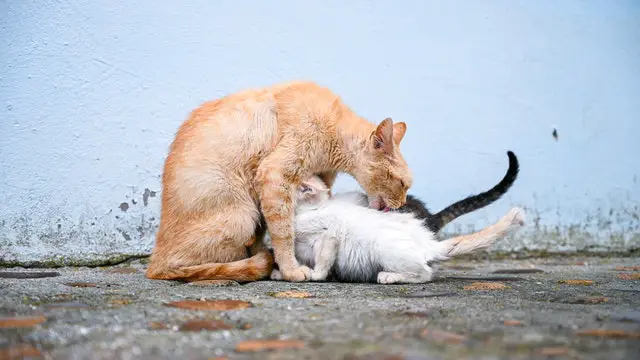
There are few things more beautiful than attending and preparing for the birth of a cat. Watching kittens come to life is an unforgettable experience. But first, it is very important that you know how to help a cat during labour so that everything goes well. At Petlifey, we explain what you should know and what to do before, during and after giving birth to a cat.
How to help a cat before giving birth
As it approaches the time of delivery, the cat will spend more and more time in arranging the nest box and installing your comfort. She probably doesn’t need your help, but you have to prepare to be able to offer it to her.
When your cat is due to give birth, you should have sterilized scissors and thread, warm boiled water, a soft cloth, towels, a hot water bottle, pencil and paper ready.
The cat will let you know with one or two soft meows when she is ready to give birth. She may come looking for you, wherever you are, so you can follow her to the nest.
Of course, it is also possible that you decide not to warn, even if you are at home at the time of delivery. You may not realize what is happening until after the kittens are born.
Some knowledge about the development of the cat fetus can be useful if you have to help the cat during the birth:
- The fetus develops in a fluid-filled pouch that is connected to the placenta, a disc of flesh attached to the uterine wall by the umbilical cord. Through this cord the fetus receives nutrients.
- During the birthing process, the muscles of the uterus contract to push the fetus down and out through the vaginal opening in its pouch.
- Most kittens are born upside down, although sometimes their paws pop out first. In this case, do not be alarmed, unless your cat is especially small or has had complications in the past.
How to help a cat during labour
Sometimes the deliveries of the cats last several hours; this is quite common. However, if the contractions have lasted a long time but the kittens are still not appearing, there is probably a problem and you should call your vet.
- You may have to help when the cat is pushing but has a hard time expelling the kittens. Do not put your fingers in the vagina of the cat and do not try to force the kittens out. Make sure your hands are very clean.
- Use a towel to hold the bag after it has peeked out a bit. Don’t pull on the kitten; you just have to hold it so that it does not get back into the mother. With each contraction a little more will appear.
- When the kitten is delivered, a little tug on the umbilical cord will release the placenta. Check that there is a placenta for each kitten.
- If material from the placenta remains inside the mother, her health can be in serious jeopardy. If this happens, you will have to call the vet.
- When the kitten has come out, you have to carefully break the bag and remove it, starting with the head.
- Cut the umbilical cord with the sterile scissors, about 2 inches from the kitten’s navel. Tie it with the sterilized thread. After a few days the cord will dry out and come off.
- If the kitten is not breathing, grab it with a towel and rub it. You should start breathing right away. You can hold the kitten upside down for a moment to help it clear its lungs.
Kittens are usually born with the pouch intact. The cat will break the bag, bite to cut the umbilical cord, and eat the bag, the cord, and the placenta.
If the kittens are born in rapid succession, the mother may not have time to do this, and you will have to help her remove the bags, etc., in the most discreet way possible.
Then the mother will lick her young to dry them. A number of meows and moans are usually heard, as kittens often begin to exercise their voices immediately.
How to help a cat after giving birth

When all the kittens have been born, the cat will clean herself, count the noses and dedicate herself to taking care of her little ones. But even if the delivery is over, there is still a bit of work to do on your part:
- You can give the cat some warm milk, because she will almost certainly be thirsty or hungry.
- Put clean sheets on the nest, and remove dirty material from the nest shortly after calving.
- A normal litter is usually four kittens, but don’t be too surprised if it only consists of one or ten.
At this point, it only remains to know the sex of the kittens and that you take care of them with a lot of love and affection. You can read what care new born cats need to learn more.






